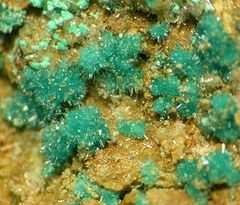Niedermayrite
From Wikipedia, the free encyclopedia
| Niedermayrite | |
|---|---|
 Niedermayrite from Ophir Hill area, Ophir District, Oquirrh Mountains, Tooele County, Utah, USA | |
| General | |
| Category | Sulfate mineral |
| Formula (repeating unit) | Cu4Cd(SO4)2(OH)6·4H2O |
| Strunz classification | 07.DD.30 |
| Crystal symmetry |
Monoclinic prismatic H-M symbol: (2/m) Space group: P 21/m |
| Unit cell | a = 5.543(1) Å, b = 21.995(4) Å, c = 6.079(1) Å; β = 92.04(3)°; Z=2 |
| Identification | |
| Color | Bluish green |
| Crystal habit | Platy euhedral crystals and as green crusts |
| Crystal system | Monoclinic |
| Cleavage | Perfect on {010} |
| Tenacity | Brittle |
| Luster | Vitreous |
| Streak | White |
| Diaphaneity | Transparent |
| Specific gravity | 3.292 |
| Optical properties | Biaxial (-) |
| Refractive index | nα = 1.599 - 1.619 nβ = 1.642 nγ = 1.661 |
| Birefringence | δ = 0.062 |
| 2V angle | Measured: 84° |
| References | [1][2] |
Niedermayrite is a rare hydrated copper cadmium sulfate hydroxide mineral with formula: Cu4Cd(SO4)2(OH)6·4H2O. It crystallizes in the monoclinic system and occurs as encrustations and well formed vitreous blue-green prismatic crystals. It has a specific gravity of 3.36.
Niedermayrite was named for Gerhard Niedermayr (born 1941), an Austrian mineralogist. It was first described in 1998 from a mine in the Lavrion District, Attica, Greece. It is also reported from the Ophir District, Tooele County, Utah.[1]
References
This article is issued from Wikipedia. The text is available under the Creative Commons Attribution/Share Alike; additional terms may apply for the media files.